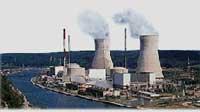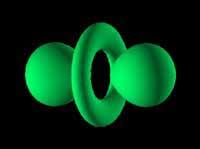Any trace of fusion?
2002/05/01 Roa Zubia, Guillermo - Elhuyar Zientzia Iturria: Elhuyar aldizkaria
Fossil fuels will not be forever. Oil and coal have been burned for a long time and will end sometime. For example, in the belief that oil was about to end, there have been a crisis in the energy field. However, seeking more or less in depth has always found some other source so far, but as our consumption is increasing, how long will this situation continue? There are those who say that the fossil fuel will run out by the year 2200.
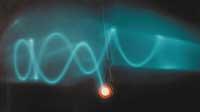
There are two main types of alternative fuels: renewable and nuclear energy. Renewables (solar, wind, hydrothermal, etc.) They are environmentally excellent, so much money is invested in this technology. However, renewables are still not willing to deal with the consumption of our society. Therefore, in many villages, a clear commitment has been made to nuclear energy.
Fission and fusion
Is using nuclear energy a good solution? The debate is on top, because from a point of view it is clear that yes and from another clear that no. Nuclear power plants can produce more energy than is necessary for our consumption, but the products involved in the process and the radioactive waste it generates are highly dangerous. However, when we talk about nuclear energy, we talk about nuclear fission in general. But there is another nuclear process, fusion. What are both?
Both have to do with the nucleus of the atom. Fission is "breaking" large cores. Therefore, the raw material for this process is uranium, the largest atom of nature. However, not all uranium nuclei are easily reliable: radioactive isotopes are essential for carrying out this process. Uranium is "enriched" in these isotopes. Another solution is to artificially make atoms heavier than uranium, such as plutonium. All plutonium isotopes are radioactive, a unique element for the production of atomic bombs. In the power plants, however, the fission has great problems, mainly because the residues that leave the reactor are also radioactive.
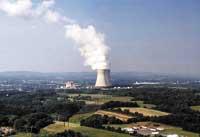
Fusion is an opposite process, that is, the union and union of two small atoms. The energy released by this process is much higher than that of fission, besides having as raw material small non-dangerous atoms, isotopes of hydrogen. This type of hydrogen, called deuterium, is very abundant in the sea. However, for the fusion to occur, you have to give it extra energy. The resulting amount is much higher, but process activation requires a lot of energy. For example, hydrogen pumps that were developed after World War II (i.e., fusion pumps) had to use a small fission pump to "launch" them. This means that to blow up the H pump you must take activation energy from another bomb like the one that was launched in Hiroshima.
Energy research and energy research
Therefore, it was not possible to exploit the fusion to produce electricity. If fusion could occur at a controllable temperature, the problem of conventional nuclear power plants could be solved. There are many projects that have to do with this research: JET in the European Union, JT-60U in Japan and NOVA, TFTR and DIII-D in the United States.
In 1985, the Soviet Union proposed an international fusion research project. This project, called ITER, was launched in collaboration with the European Union, Japan and the United States. The objective was to investigate the next logical step of the research of the time: to study plasma physics at high temperature on the scale of large reactors. Project in progress. According to the results obtained, in addition to causing fusion, they expect to adapt to produce electricity.
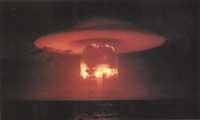
In 1992 Canada and Kazakhstan also joined the project of the hand of Europe and Russia, which had already disappeared from the Soviet Union. The United States left the project in late 1999.
In general, three fusion strategies have been tested. The great activation energy is to overcome the internuclear repulsion forces, positively charged and difficult to collide, which should somehow be 'forced' to go to the same place. The three usual ways to achieve this are those of magnetic field, gravitational field and moment of inertia.
The Sun, for example, fuses the atoms of hydrogen because its gravitational field is very large. Several experiments have sought to create 'laboratory stars'. Other times they are controlled with large magnetic fields so that atoms can cause the collision of the cores and, finally, have been the means of great pressure exerted by inertia.
In these three types of experiments the atoms are in a plasma state, that is, as fluids of charged particles. The plasma conducts electricity and can also be controlled by magnetic fields. Before knowing the final research, only this fusion situation was considered adequate.
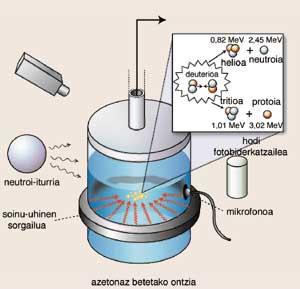
Surprising experiments
Physicists Martin Fleischmann and Stanley Pons announced in 1989 that they achieved a cold fusion (at laboratory temperature). The announcement was not made in scientific publications but in common media. In addition, the experiment could not be repeated, so this research was considered a great failure.
In March, the journal Science has released a cold fusion experiment. U.S. physicist Rusi Taleyarkhan, from the Oak Ridge laboratory, introduced the acetone with deuterium instead of hydrogen into a cylindrical container and bombarded it by sound waves. At the same time, it bombed above all a range of high speed neutrons. In this way, bubbles of one millimeter diameter were formed that interacted with deuteriums that supposedly became fusion. This technique, called acoustic cavitation, is independent of the techniques used previously.
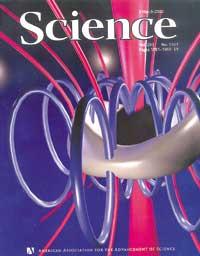
Two deuterium atoms create, by fusion, an atom of helium and a neutron. But that's not what scientists have seen. In fact, in the same process, tritium and protons can be formed, but without a fusion. The researchers say that there have been neutrons and tritium, that is, both reactions have occurred, so they announce that there has been a fusion.
One of the products of the experiment has been the neutron, but the other the tritio. Therefore, the question has remained in the air. Has the fusion really happened or has only tritio arisen?
The editors of the journal Science decide to publish the article. Do you think, therefore, that fusion actually occurred? This journal, like all research journals, does not publish articles without the judgement of experts in the subject. This is what the journal Science has done with the article of the fusion.
These experts requested the detection of neutrons with a more accurate detector. Then American physicists Dan Shapira and Michael Saltmarsh tried to repeat the Taleyarkhan experiment with this detector and did not detect neutrons. They concluded that no fusion occurs. But other scientists have also criticized this last experiment.
It was decided to inform the journal Science of the cold fusion, a decision that is justified in the editorial. Editor Donald Kennedy explains the controversy aroused. Accepting this debate, the editors have defended the need to report this type of research and that in these cases the criteria should not be very strict.
Science has said, but the debate is alive.
The Sun knows how to do so
Fusion in stars is easy. In fact, fuels are large amounts of hydrogen, in which little by little new atomic elements are being formed. In the most proportional fusion reaction, helium is generated from hydrogen atoms.
To obtain helium from hydrogen, three fusion reactions are produced:
The union of two protons in the first gives rise to a deuterium nucleus, that is, to a structure of protons neutrons. This means that a proton has become a neutron, a process that is compensated by the release of a positron and energy. In short, a piece of matter has become energy.
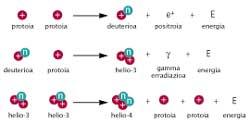
The deuterium formed in the first reaction reacts with another proton in the second to form a nucleus of the helium-3 atom. In this process energy is also released in the form of heat and radiation (gamma rays). Helium-3 is not the most stable isotope of helium, but the process is not interrupted. The third reaction consists of reorganization between two helium-3 cores, a single helium-4, to supply two protons and energy.
Energy is released in the three processes. It must be taken into account that in order for the third reaction to occur, the previous two have had to occur twice. Most is thermal energy, but gamma radiation is also generated. This energy comes from matter, as Einstein's special theory of relativity announced.
E = mc 2
This formula allows to easily calculate that a gram of matter, when transformed into energy, releases 9 x 10-13 joules.
E = (10 -3 kg) (3 x 10 8 m/s 2 ) 2 = 9 x 10 -13 joules
Although this number is difficult to interpret, with other comparisons you can appreciate that it is a lot of energy. If the fusion was made from deuterium and deuterium outside sea water, 50 vessels of sea water would provide an energy equivalent to 2 tons of coal.
The amounts of energy are produced in those proportions in the Sun and similar stars. But in the laboratory scientists have tried for years to influence fusion from the atoms of deuterium and tritium. As has already been indicated, deuterium is found in marine waters and tritio can be obtained from lithium metal bombarding with neutrons.
Now, in the experiment of the Oak Ridge laboratory, the deuterium acetone has been removed to cause fusion. Although they have achieved it, they have produced much less energy than is obtained from deuterium and tritium, approximately a quarter.

Gai honi buruzko eduki gehiago
Elhuyarrek garatutako teknologia




